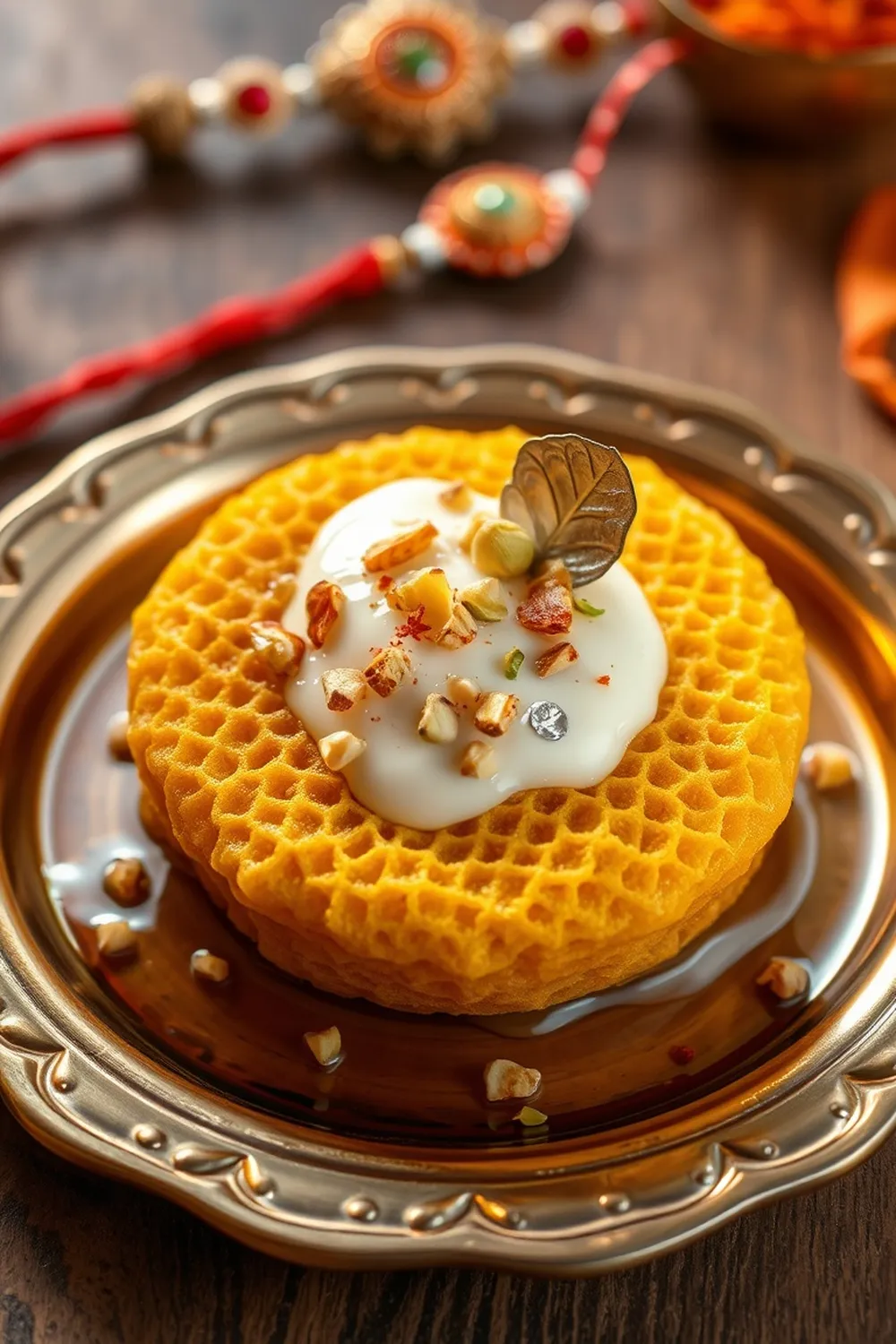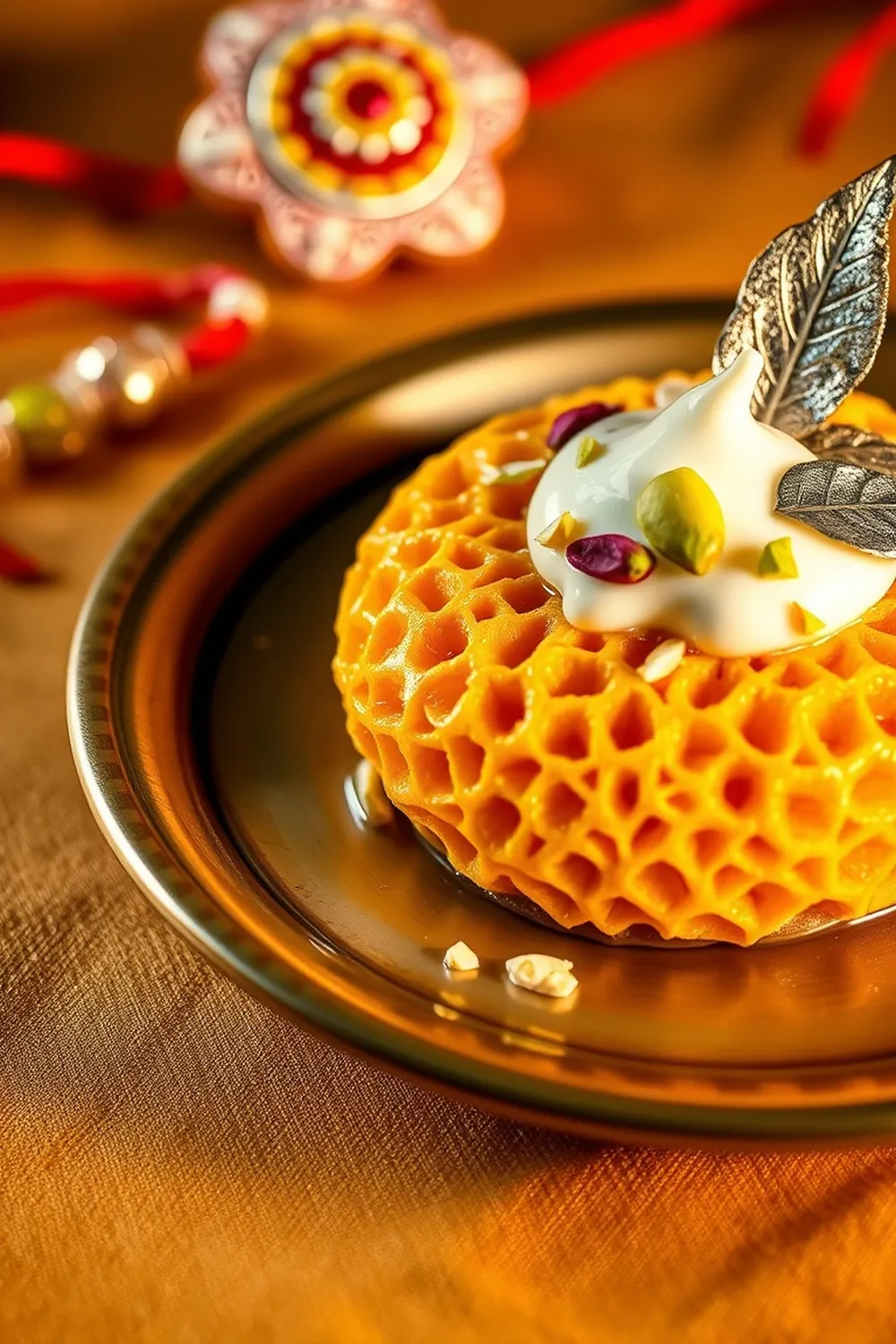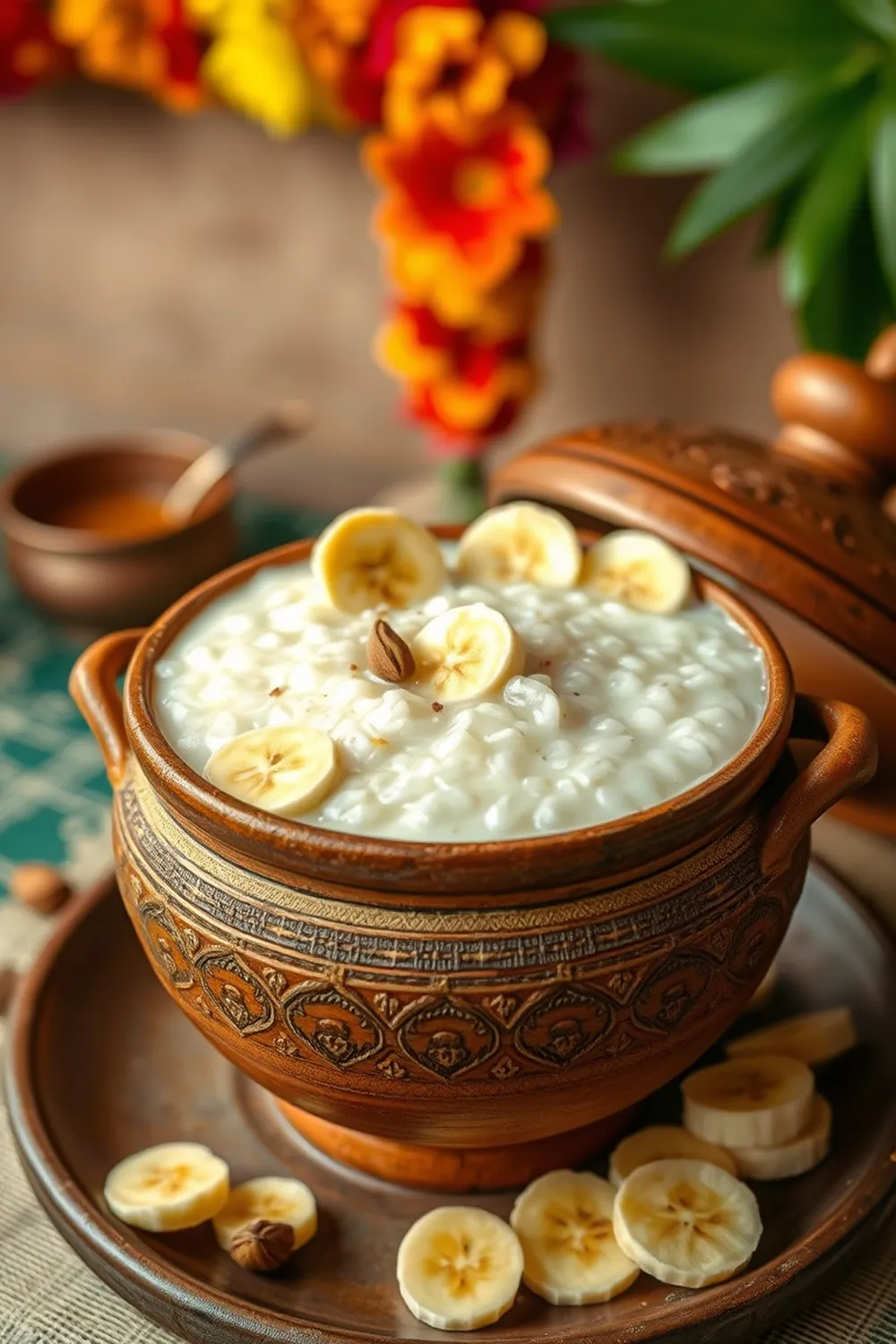- Whip ghee until light and fluffy.
- Combine flour, 1/4 cup water, and 1/2 cup chilled milk to create a smooth batter.
- Thin the batter with additional 1/2 cup water and 1/4 cup milk to achieve a pouring consistency.
- Heat ghee or oil in a deep pan. Pour batter in thin streams to create a honeycomb pattern.
- Create a center hole using a ladle and carefully add 5-6 layers of batter for structural integrity.
- Fry until golden brown and crisp, then drain on a wire rack.
- Prepare sugar syrup by boiling sugar and water until it reaches a one-thread consistency. Add saffron for flavor and color.
- Make rabri by slowly reducing milk, collecting and stirring in the cream layers, and adding saffron.
- Soak the ghevar in warm sugar syrup, top with rabri, and garnish with chopped nuts.
- Calories:450 kcal25%
- Energy:1882 kJ22%
- Protein:8 g28%
- Carbohydrates:60 mg40%
- Sugar:40 mg8%
- Salt:150 g25%
- Fat:25 g20%
Last Updated on 6 months ago by Neha Deshmukh
Authentic Ghevar Recipe – Saffron Rabri & Honeycomb Delight
Introduction
Oh, Ghevar! Just the name conjures up images of festive celebrations and sweet, happy memories. This isn’t just a dessert; it’s an experience. I remember the first time I tried to make Ghevar – it was a bit of a disaster, honestly! But after a few attempts (and a lot of patience!), I finally cracked the code. Now, I’m so excited to share my family’s recipe with you. Get ready to impress everyone with this stunning Saffron Rabri Ghevar – a true honeycomb delight!
Why You’ll Love This Recipe
This Ghevar recipe isn’t just about following steps; it’s about creating a little bit of magic in your kitchen. It’s perfect for special occasions like Raksha Bandhan, Teej, or any celebration where you want to serve something truly special. The combination of the crispy Ghevar, fragrant saffron rabri, and crunchy nuts is simply irresistible. Plus, the satisfaction of making this intricate dessert from scratch is huge.
Ingredients
Here’s what you’ll need to create this masterpiece:
- 1 cup ghee (approximately 225g)
- 1.5 cups all-purpose flour (approximately 190g)
- 1/4 cup water (approximately 60ml)
- 1/2 cup chilled milk (approximately 120ml)
- 1.5 cups sugar (approximately 300g)
- 1/2 tsp saffron strands
- 4 cups whole milk (for rabri, approximately 950ml)
Ingredient Notes
Let’s talk ingredients – a few little tips can make all the difference!
Ghee – The Foundation of Flavor: Ghee is essential for that authentic Ghevar taste and texture. Don’t skimp on quality here! It needs to be good quality, and clarified butter is best.
All-Purpose Flour – Achieving the Right Texture: We’re using all-purpose flour for a classic Ghevar. Make sure it’s plain flour, not self-raising.
Saffron – The Royal Spice: A little saffron goes a long way! It adds a beautiful color and a delicate aroma. Soak the strands in a tablespoon of warm milk for about 20 minutes to release their flavor before using.
Whole Milk – For Rich Rabri: Full-fat whole milk is the way to go for the creamiest, most decadent rabri. It takes time to reduce, but trust me, it’s worth it!
Regional Variations in Ghevar Styles
Ghevar isn’t one-size-fits-all! You’ll find different styles across Rajasthan and beyond. Some are flatter, some are more conical, and the toppings vary too. In some regions, they add cardamom or rosewater to the syrup. This recipe focuses on the classic, slightly conical Ghevar topped with saffron rabri, which is a favorite in my family.
Step-By-Step Instructions
Alright, let’s get cooking!
- First, let’s whip that ghee! In a bowl, combine the ghee with a few ice cubes. Keep whipping until it becomes light, fluffy, and pale in color. This is key to a crispy Ghevar.
- In a separate bowl, mix the flour, 1/4 cup of water, and 1/2 cup of chilled milk. Stir until you have a smooth batter – no lumps allowed!
- Now, thin out the batter. Add the remaining 1/2 cup of water and 1/4 cup of milk, mixing well to achieve a pouring consistency. It should be similar to pancake batter.
- Heat ghee or oil (I prefer ghee for the flavor) in a deep, heavy-bottomed pan over medium-high heat. The oil should be hot, but not smoking.
- Here comes the tricky part! Pour the batter into the hot ghee in a thin, circular stream. It will sizzle and create a honeycomb pattern.
- Using the back of a ladle, gently create a small hole in the center of the Ghevar. This helps it cook evenly. Add 5-6 more layers of batter, building up the structure.
- Fry the Ghevar until it’s golden brown and crispy all over. This takes patience!
- Carefully remove the Ghevar from the ghee and drain it on a wire rack to remove excess oil.
- While the Ghevar is cooling, let’s make the sugar syrup. In a saucepan, combine the sugar, water, and saffron strands. Boil until you reach a thread consistency (more on that in the FAQs!).
- Now for the rabri! Reduce the milk in a heavy-bottomed pan over medium heat, stirring frequently to prevent sticking. Collect the cream layers that form on top and keep reducing until it thickens. Add the saffron strands during the last few minutes.
- Once the Ghevar has cooled slightly, gently soak it in the warm sugar syrup.
- Top with the luscious saffron rabri and garnish with your favorite nuts – pistachios, almonds, and cashews are lovely.
Expert Tips
A few things I’ve learned along the way…
Achieving the Perfect Honeycomb Pattern: The key is to pour the batter in a thin, consistent stream. Practice makes perfect!
Maintaining Batter Consistency: If the batter becomes too thick, add a little more milk. If it’s too thin, add a tiny bit of flour.
Frying Temperature Control: Keep a close eye on the oil temperature. If it’s too low, the Ghevar will be soggy. If it’s too high, it will burn.
Rabri Consistency – A Guide: The rabri should be thick enough to coat the back of a spoon. It will thicken further as it cools.
Variations
Want to switch things up? Here are a few ideas:
Vegan Ghevar Adaptation: Substitute the ghee with a neutral-flavored vegetable oil and the whole milk with plant-based milk (cashew or almond milk work well).
Gluten-Free Ghevar Adaptation (Using Besan/Rice Flour): Replace the all-purpose flour with a mix of besan (gram flour) and rice flour. You might need to adjust the liquid slightly. My friend, who’s gluten-free, swears by this!
Spice Level – Cardamom Infusion: Add a pinch of cardamom powder to the batter for a warm, aromatic flavor.
Festival Adaptations – Raksha Bandhan & Teej Special: Decorate with silver leaf (varak) for an extra festive touch during Raksha Bandhan or Teej.
Serving Suggestions
Ghevar is best served slightly warm or at room temperature. It’s a showstopper on its own, but you can also serve it with a scoop of ice cream or a side of fresh fruit.
Storage Instructions
Leftover Ghevar can be stored in an airtight container at room temperature for up to 2-3 days. It will lose some of its crispness over time, but it will still be delicious!
FAQs
What is Ghevar and its origin? Ghevar is a traditional Rajasthani sweet, believed to have originated in the royal kitchens. It’s made by pouring a flour-based batter into hot ghee and creating a honeycomb-like structure.
Can I make Ghevar without a special Ghevar mould? Yes, you can! While a mould helps create a perfect shape, you can make Ghevar without one by carefully pouring the batter in a circular motion.
How do I know when the sugar syrup has reached the correct consistency? The “thread consistency” means that when you take a little syrup between your thumb and forefinger and let it cool slightly, it should form a single, unbroken thread.
What is the best way to store leftover Ghevar? Store it in an airtight container at room temperature. Avoid refrigerating, as it can make it soggy.
Can I use different types of milk for making Rabri? While whole milk is best, you can use full-fat milk. However, the rabri won’t be as rich and creamy.










